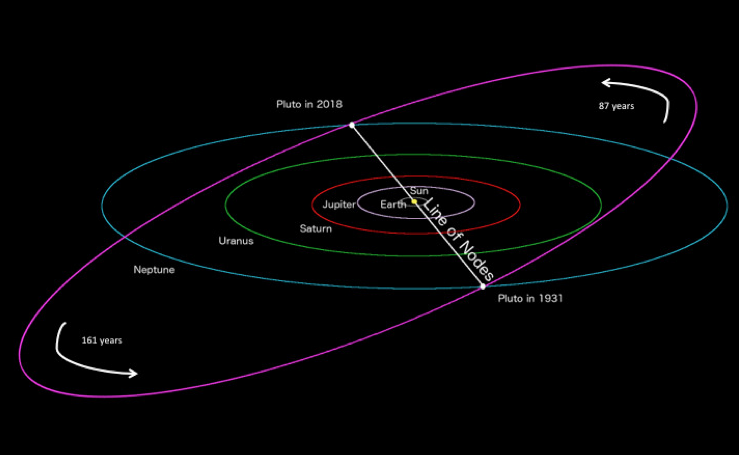
Most of us have heard of Pluto’s downgrade from the category of planet to “dwarf planet,” but it is less well-known why it was demoted. One of the main reasons had nothing to do with size and everything to do with Pluto’s strange orbit. Instead of orbiting with the sun roughly at the center of the orbit and on the same plane as the eight main planets of the solar system, Pluto orbits in a manner very different from the others, as the above image shows. Its orbit is much more elliptical and Pluto is sometimes very close to the sun and sometimes very far away. As it turns out, Pluto’s orbit is actually not strange at all when taken in the context of other objects in the Kuiper Belt which actually orbit similarly to Pluto. This puts Pluto in a category with these Kuiper Belt objects while at the same time distinguishing it from the other main planets, all of which contributed in Pluto’s demotion to the category “dwarf planet.” There are more “dwarf planets” than Pluto, including Ceres (which is in between Mars and Jupiter) Haumea, Makemake, and Eris (all three of which are located in the outer solar system along with Pluto).
Astrologically speaking, Pluto has had an important position in the birth chart since its discovery in the 20th century; however, with the recent discovery of these other objects which are very similar to Pluto, they should be considered with the same importance as Pluto. Unfortunately, while Ceres has seen some added importance, Haumea, Makemake, and Eris are virtually ignored in many birth charts, especially those accessed online. Will the ancient tradition of Astrology survive the frequent discoveries of modern Astronomy? While it has done so since the birth of modern Astronomy, Astrology will continue to be tested in this regard!
I’m curious if the surface characteristics of Pluto are consequence of its unique and varied elliptical orbit. Maybe that can explain its massive, heart-shaped, smooth glacial region. I’d also be interested in seeing what the planet may look like on the opposite side of its orbit from where New Horizons did its flyby. Maybe it would look exactly the same, or maybe some variables could have an effect.
LikeLike
Yeah, as sad as it was, Pluto’s demotion was justified. The Kuiper belt is actually packed with objects! The edges are defined via orbital resonances, in particular the 2:3 and 1:2 resonances with the idea being that these resonances end up determining the stability of an object’s individual orbit. Seeing how these resonances evolve over billions of dynamical timescales is currently the work of some smart data scientists!
https://en.wikipedia.org/wiki/Orbital_resonance
LikeLike